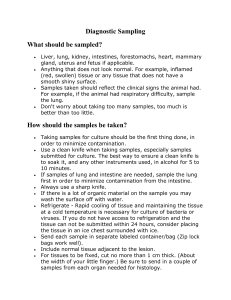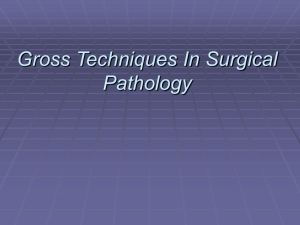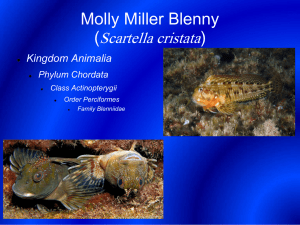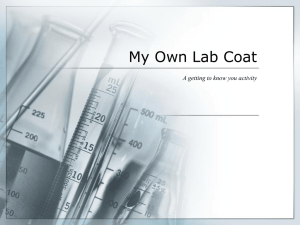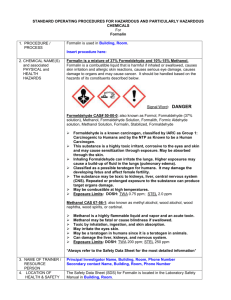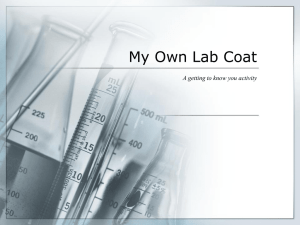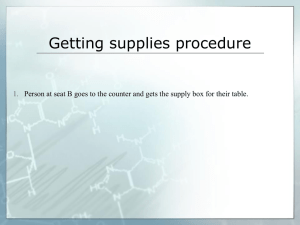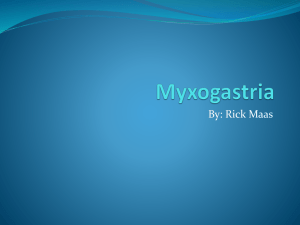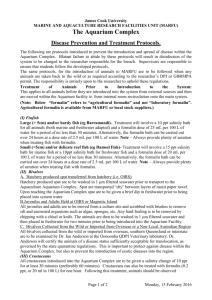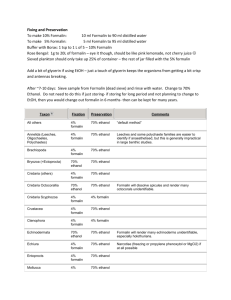Fish Disease and Treatment: A Quick Guide 2011
advertisement
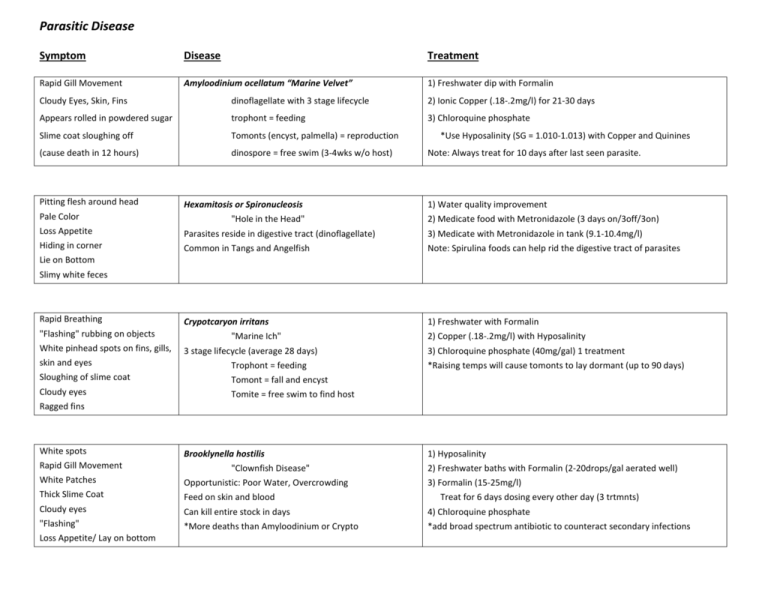
Parasitic Disease Symptom Disease Treatment Rapid Gill Movement Amyloodinium ocellatum “Marine Velvet” 1) Freshwater dip with Formalin Cloudy Eyes, Skin, Fins dinoflagellate with 3 stage lifecycle 2) Ionic Copper (.18-.2mg/l) for 21-30 days Appears rolled in powdered sugar trophont = feeding 3) Chloroquine phosphate Slime coat sloughing off Tomonts (encyst, palmella) = reproduction (cause death in 12 hours) dinospore = free swim (3-4wks w/o host) Pitting flesh around head Pale Color Hexamitosis or Spironucleosis "Hole in the Head" *Use Hyposalinity (SG = 1.010-1.013) with Copper and Quinines Note: Always treat for 10 days after last seen parasite. 1) Water quality improvement 2) Medicate food with Metronidazole (3 days on/3off/3on) Loss Appetite Parasites reside in digestive tract (dinoflagellate) 3) Medicate with Metronidazole in tank (9.1-10.4mg/l) Hiding in corner Common in Tangs and Angelfish Note: Spirulina foods can help rid the digestive tract of parasites Crypotcaryon irritans 1) Freshwater with Formalin Lie on Bottom Slimy white feces Rapid Breathing "Flashing" rubbing on objects White pinhead spots on fins, gills, "Marine Ich" 3 stage lifecycle (average 28 days) skin and eyes Trophont = feeding Sloughing of slime coat Tomont = fall and encyst Cloudy eyes Tomite = free swim to find host 2) Copper (.18-.2mg/l) with Hyposalinity 3) Chloroquine phosphate (40mg/gal) 1 treatment *Raising temps will cause tomonts to lay dormant (up to 90 days) Ragged fins White spots Rapid Gill Movement Brooklynella hostilis "Clownfish Disease" 1) Hyposalinity 2) Freshwater baths with Formalin (2-20drops/gal aerated well) White Patches Opportunistic: Poor Water, Overcrowding Thick Slime Coat Feed on skin and blood Cloudy eyes Can kill entire stock in days 4) Chloroquine phosphate "Flashing" *More deaths than Amyloodinium or Crypto *add broad spectrum antibiotic to counteract secondary infections Loss Appetite/ Lay on bottom 3) Formalin (15-25mg/l) Treat for 6 days dosing every other day (3 trtmnts) Parasitic Disease cont… Symptom Disease Treatment Loose/Missing scales Uronema marinum 1) Proper husbandry Thickened Slime Coat Normal fauna of decomposition 2) Formaline Lesions with red rings Opportunistic ectoparasite 3) Chloroquine phosphate Tissue/Muscle exposure *Does not respond to copper! Ragged Fins "Flashing" Rapid/Labored Breathing Black pinhead spots "Flashing" Turbellarian "Black Ich" Rapid Breathing Free-living flatworm (monogenetic) Listless 10 day lifecycle at 76 degrees F Loss Appetite Likes high organic waste "Flashing" and scratching Flukes and Trematodes Swimming erratically, shaking Monogenean are most problematic Rapid Gill Movement Usually species specific Loss of appetite Hooks and suckers to anchor into gills 1) Formalin (15-25mg/l) Treat for 6 days dosing every other day (3 trtmnts) 2) Praziquantel 1-5mg/l (once a week for three weeks) 1) Freshwater Dip with Formalin 2) Praziquantel 1-5mg/l (once a week for three weeks) Affect gills, eye, skin *allow for secondary infections Can see parasite on fish Crustacean parasites 1) Remove with tweezers and disinfect area with H2O2 or Iodine Filaments (string or coil from fish) Isopods = wounds "fish louse" 2) Formaline Lesions or wounds Copepods = bore into tissue (female) 3) Trichlorfon (100mg/100l) - several treatments since kills young Raised scales/Missing scales parasites not the female attached. Bacterial Infections Symptoms Disease Treatment Fin damage from transport, Pseudomonas, Vibrio, Aeromonas, Cystophoga, 1) Kanamycin (50-100mg/l) treat every 3 days for 7-10 days fights or Edwardsiella 2) Neomycin (65mg/l) Every 24 hours *begin outside work inward 2-3 days red inflamed area seen Open wound grows larger and 3) Nifurpirinol (1-2mg/l) 5min-1hr bath every 24 hours Furunculosis *secondary to Amyl, Brook, Uronema deeper 1) Nifurpirinol 2) Kanamycin 3) Sulfanthiazole (.2-.4mg/10gal) for 3 days 4) Sulfamerazine (220mg/kg) in food 7-10 days Chronic condition Weight Loss (pinched abdomen) Mycobacteriosis, Tuburculosis "Wasting Away Disease" Swollen pectoral area (liver) *zoonotic* Bulge Eyes Internal bacteria None - by time recognize the signs, usually too late (Euthanize) Many times must sterilize tank, nets, etc. Scale loss White skin patches Hiding behavior Swollen abdomen Internal bacteria 1) Nifurpirinol (2-3mg/l) for 7-10 days Raised Scales 2) Oxytetracycline (20-30mg/l) for 3-5 days Anal Distention 3) Erythromycin (10mg/l) for 3 days Popeye Refuse food Fungal Infections Symptoms Disease Treatment Raised Scales External 1) Improve water quality Light or dark pigment Secondary to where slime coat has gotten 2) Boost immune system Cotton-like tufts (fin, eye, mouth) Circular shape damaged - Uronema Poor water quality 3) Sulfa drugs (.65-1.3mg/l) for 7-10 days 4) Miconazole applied directly to area infected Overcrowding Seahorses, Clownfish, Butterflyfish more prone Emaciated Internal (Ichthyophonus boferi) Abnormal swimming (corkscrew) Popeye, Sandpaper Disease, Reeling Popeye or Exopthalmia Darkening of skin Invades liver, kidney and spleen Usually from feeder fish or raw fish food 1) Prevention only 2) Phenoxyethanol (12.5ml/4l) has been tried Note: can take months to appear, so QT not necessarily help identify Good water quality and safe food is best preventative Viral Infections Symptoms Disease Treatment Enlarged cells (appear as white) Lymphocystis "Nodule Disease" 1) Sedate fish and cut fins back than apply antiseptic Salt-like appearance begin at fins Iridovirus invades from rough handling then moves toward body or shipping stress Cauliflower-like cells (grapes) Damages to slime coat allow access 3) Tetrahydrozoline (Visine) to infected areas under 100X magnification Fine to diseased overnight 4) 35% Hydrogen Peroxide (1ml/10gal) Mouth and/or gills growths 2) Sedate and apply topical tincture (merthiolate, mercurochrome, or 10% silver nitrate) 5) Let it run its course or euthanize if too far gone Non-Pathogenic Symptoms Disease Treatment Bubbles in eyes, fins, body, gills Supersaturation "Gas Bubble Disease" 1) Fix any air leak in pumps Embolisms Water becomes supersaturated with gas 2) Aerate the water Asphyxiation because of air forced into (higher than 3) Equalize the temperature of the water prior to water changes Mass deaths in tank atmospheric) 4) Avoid any rapid raise in temperature Rapid raise in temperature or depressurization of water Disfiguring and discoloration of head and body along the lateral line HLLE = Head and Lateral Line Erosion Unknown cause, very argumentative Possibilities include: 1) Water Quality High 2) Proper Diet 3) Ground the tank Nutrition/ Vitamin deficiency Pathogens Stray Voltage Copper Poor Water Quality Activated Carbon Usage (newer thought) *More rare In Reef than FO or FOWLR Standard Arsenal of Drugs: Formalin (37% Formeldahyde), Praziquantel (and Metronidazole), Gentamycin or other wide spectrum antibiotic (gram negative orientated). Good source of meds is National Fish Pharmaceuticals (www.nationalfishpharm.com)


